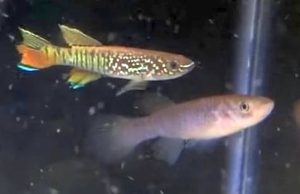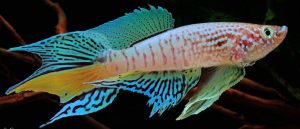The Blue Gularis Killifish (Fundulopanchax sjoestedti) is native to the water holes, streams, and marsh areas of Nigeria and Cameroon, Africa.
Many tropical fish keeping enthusiasts regard the Blue Gularis Killifish as one of the best known and most sought after of all killifishes.
Fundulopanchax sjoestedti is a large, colorful, semi aggressive, killifish that possesses a three forked tail that often has long streamers emanating from the tips.
Males have a distinctive color pattern that is predominately blue on the back and orangeish colored on the flanks, with dark reddish brown stripes. The sides of the fish are purplish in color, overlaid with white spots and the head also has white spots with red markings.
Adult males are a vibrant blue and red color, with a distinctive three pronged “ice blue” colored tail that is sprinkled with random black striations and spots.
The middle of the three pronged tail is colored a light to fiery orange that is lightly outlined in black. They have rather large pectoral fins that are trimmed in white along the outer edges and splashed with brown spots. The yellowish blue dorsal fin is patterned similar to the caudal fin.
Several colour forms are available to tropical fish keeping enthusiasts, including a smaller variety known as the Dwarf Red Gularis.
Female Blue Gularis are smaller and lack the gaudy colors of the male. They are usually colored a drab gray to brown color and have faint black spots, stripes, and reddish spots on the fins, with faint light red bars behind the eye.
Blue Gularis are relatively easy to keep in an aquarium environment and will thrive in a wide range of water conditions.
Although they can be kept in a community aquarium, they do best when housed alone in a biotope setting in a densely planted aquarium of at least 20 gallons, with a fine gravel or sandy substrate and with a layer of peat moss or Indian Almond Leaves on the bottom to keep the water softer and on the acidic side. Driftwood
or bogwood
should be provided for cover along with a fewfloating plants
to diffuse any overhead lighting and lessen the chances of the fish jumping from the tank. Blue Gularis are accomplished jumpers, so the tank should have a tight fitting cover if floating plants are not provided.
Blue Gularis are relatively easy to breed substrate spawners, but getting the eggs to hatch into fry can sometimes be a challenge. Because they are not an annual species, it is not necessary to remove their eggs from the water after spawning for them to hatch. Females will deposit their eggs, which will generally hatch out in about 2 months, in a spawning mop or in Java Moss
. After hatching, the young should be placed in a separate rearing tank and fed newly hatched brine shrimp,daphnia, or grindal worms.
Although many breeders use no filtration during breeding, a small corner sponge filter is recommended to promote water circulation, prevent stagnation, and minimize any fungal growths on the eggs. The breeding tank should be kept dark with a layer of peat or Indian Almond Leaves on the bottom, and the water in the breeding tank should be soft, with a pH of about 6.5 and a temperature in the range of 74 to 78°F.
Because young Blue Gularis pairs commonly produce infertile eggs, it’s a good idea to choose an older trio of one male, to two females and separately condition them until the females become plump, on a diet of live black worms, tubifex, chopped earthworms, or mosquito larvae, before introducing them into the spawning tank.
If the water conditions are acceptable to the trio, spawning should commence rapidly with the females depositing their eggs on the spawning mops,, Ja
va Moss
, or peat moss on the tank bottom. A week or so after spawning, place the parents in separate tanks so the females can recuperate
Some of the eggs will be eaten if they are left in the breeding tank with the parents, so it’s a good idea to either remove the parents or the eggs, a week or so after each spawning.
When professional breeders incubate the eggs in water, they transfer the eggs into to a small tank with some of the original water from the spawning tank, to a depth of about 1 or 2 inches. A few drops of Methylene Blue is then added to the water, and because the eggs are light sensitive, the tank is kept in complete darkness for about 3 weeks. Daily checks are made for any white or fungused eggs which should be immediately removed.
An alternate method of hatching out the eggs is to remove any white (infertile) eggs from the tank a few days after spawning, and placing them on a bed of moist peat to incubate them. Allow the peat from the aquarium to dry on a paper towel for a couple of hours, and then place it in a plastic zip lock bag labeled with the spawning date. Keep the bag at a room temperature of 70 to 75 degrees for 10 to 12 weeks, and then place the eggs with the peat into the rearing tank. Wetting the eggs simulates the onset of rains in arid climates where the eggs remain buried in the soil and stimulates hatching.
The fry have no yolk sacs and are able to eat microworms and newly hatched brine shrimp within an hour or so after hatching.
One of the biggest problems Fundulopanchax sjoestedti breeders encounter using the first method is infertile or fungused eggs, however, the use of Indian Almond leaves will often solve the fungus problem. The decomposition of the leaves in the tank produces desirable chemicals and microorganisms that can minimize fungus problems and be a benefit to the fry.
In their natural habitat, Blue Gularis feed on a variety of worms, crustaceans, mosquito larvae, small fish, and animal matter. In an aquarium environment, they will thrive on live or frozen blackworms, bloodworms, daphnia, white worms
, brine shrimp, tubifex, and chopped earthworms.
Although they will occasionally eat prepared and freeze dried foods, it should not be their primary diet.
When housed In a community tank, do not keep them with small guppies as they will hunt them down and eat them.
Tropical fish keeping enthusiasts can purchase Blue Gularis Killifish from specialty shops and from breeders online when they are approximately 1″ to 2-1/2″ in size. They are generally sold in pairs and command high prices.
Minimum Tank Size: 20 gallons
Care Level: Moderate
Temperament: Semi-aggressive
Hardiness: Moderately Hardy
Water Conditions: 73-79° F, KH 6-12, 5-20H, pH 6.0-8.0
Max. Size: 5¼”
Color Form: Black, Blue, Green, Red, Tan, Yellow
Diet: Carnivore
Compatibility: Community and Biotope tanks
Origin: Nigeria, Cameroon, tank raised
Family: Aplocheilidae
Lifespan: 3-5 years
Aquarist Experience Level: Experienced




